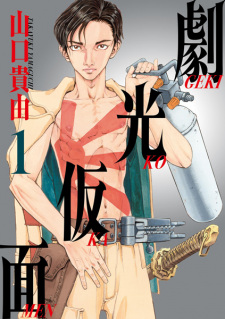I think the description on MAL for this series does a disservice to some of the more strange elements at play in the world of Gekikou Kamen but also sets the tone for the kind of themes present in the manga. The story centers around a club called Tokubiken, a group of Tokusatsu fanatics dedicated to creating functional suits for their respective Tokusatsu heroes. In one of his other series, Shigurui, the author, Takayuki Yamaguchi, shows his exhaustive attention to detail regarding the techniques used by characters in that manga, this can also be seen in Gekikou Kamen through the use of narration and inner
...
monologues that thoroughly explain the intricacies of the Tokusatsu heros' suits, weapons, and their history. In different instances, the series makes use of real-life figures under different names, such as the case of Takeshi Hongo and his accident while filming the original Kamen Rider series and Eiji Tsuburaya's involvement with war propaganda (special effects director for Godzilla and founder of Tsuburaya Productions responsible for Ultraman). The series' focus varies depending on each story arc but one thing that stays constant is the passing of time, not only in showing the change between seasons but also in how it affects the relationships of our characters.
While I think the most important character in the series is Otoya Jissouji, as he is the one who takes on the protagonist role for most of what constitutes the manga's serialization, each of the members of Tokubiken is denotably devoted to Tokusatsu even in their daily lives. They aren't just knowledgeable about their favorite films/series, they too follow the way their heroes act. This obsession is at times borderline fetishistic, coupled with the amount of nudity depicted in the manga. Nevertheless, it is the driving factor behind the vigilantism enacted by the characters. Take away some of the more strange and raunchy elements and Gekikou Kamen still works as a story of ordinary people becoming superheroes, yet it's the more bizarre elements the ones that give way to a rather unique series.
In essence, the manga is about growing out of something you once loved passionately, or rather fighting back against that notion as some of the characters' jobs are directly related to the Tokusatsu industry. Likewise, the root of the conflicts in the series revolves around the consequences of highly functional Tokusatsu suits, more often than not the law obfuscates the implementation of real-life suits in the series and serves as a frequent reminder to our characters. Not only that, it sometimes results in some very unsavory situations by way of others pitting the love they share for Tokusatsu against them.
Still, even if I appreciate many of the things Gekikou achieves it's far from flawless in execution. The art can have moments of brilliant detail and poses but sometimes throws you off with the occasional character that looks contrastingly out of place in relation to Yamaguchi's designs. I suspect it must be the work of an assistant, which isn't inherently bad in and of itself (it's good for authors to find help to reach deadlines and free heavy workloads, it's necessary for the industry) but if you put said characters in the forefront of a panel instead of just the background it creates some dissonance. Another issue I have with the way the story is presented is the narration, this was also an issue present in Shigurui that was alleviated by considerably cut-down narration in the anime adaptation, it's not that I don't want the required context being the Tokusatsu newbie I am, is just it sometimes lessens the effectiveness of the story. Speaking of which...
I only really have one point of comparison to another Yamaguchi work, and that is Shigurui. There the basic story was laid out in Norio Nanjo's novel, which was later adapted by Yamaguchi where he tweaked some of the details and extended the original 30 or so pages Mumyou Sakaranage's chapter takes up. There it felt like the story never deviated from the main plot aside from a particular story arc. Here, the flow of the story is never concise, it starts like a human drama series but then you begin to feel as if the manga is holding back its trump card and reach a point where it seems to be the case, a concrete turning point, but then it circles back to being human drama. It's a bit frustrating as a reader, nonetheless, I still feel compelled to read the next chapter.
In conclusion, Gekikou Kamen has an eccentric cast of characters to follow who all share a passionate love for a hobby and carry on living according to the values of their fictional heroes which lead them to encounter similarly peculiar foes. I wouldn't personally know if someone into Tokusatsu would like it but I think anyone who is interested in the topic or knows nothing about it will find it all the more amusing. I hope to have laid out my thoughts without giving away much of the surprises it has in store for new readers.
Alternative TitlesSynonyms: Gekiko Kamen Japanese: 劇光仮面 InformationType: Manga
Volumes: Unknown
Chapters: Unknown
Status: Publishing
Published: Dec 10, 2021 to ?
Demographic:
Seinen
Serialization:
Big Comic Superior Authors:
Yamaguchi, Takayuki (Story & Art) StatisticsScore: N/A1 (scored by - users) 1 indicates a weighted score. Ranked: #332582 2 based on the top manga page. Please note that 'R18+' titles are excluded. Popularity: #21142
Members: 649
Favorites: 0 Available AtResources | Reviews
Filtered Results: 1 / 1
Sort
Your Feelings Categories Jan 26, 2025
I think the description on MAL for this series does a disservice to some of the more strange elements at play in the world of Gekikou Kamen but also sets the tone for the kind of themes present in the manga. The story centers around a club called Tokubiken, a group of Tokusatsu fanatics dedicated to creating functional suits for their respective Tokusatsu heroes. In one of his other series, Shigurui, the author, Takayuki Yamaguchi, shows his exhaustive attention to detail regarding the techniques used by characters in that manga, this can also be seen in Gekikou Kamen through the use of narration and inner
...
|

